Trends in alcohol-related admissions to hospital by age, sex and socioeconomic deprivation in England, 2002/03 to 2013/14
- PMID: 28482876
- PMCID: PMC5423017
- DOI: 10.1186/s12889-017-4265-0
Trends in alcohol-related admissions to hospital by age, sex and socioeconomic deprivation in England, 2002/03 to 2013/14
Abstract
Background: Prevalence of alcohol-related harms in England are among the highest in Europe and represents an important policy issue. Understanding how alcohol-related trends vary by demographic factors is important for informing policy debates. The aim of our study was to examine trends in alcohol-related admissions to hospital in England, with a focus on variations by sex, age and socioeconomic deprivation.
Methods: We used data on hospital admissions for England for the financial years 2002/03 to 2013/14. Our four main outcome variables were acute and chronic conditions wholly and partially attributable to alcohol consumption. We also looked at four specific conditions wholly attributable to alcohol. Socioeconomic deprivation was measured using the English Indices of Deprivation of a patient's residence (categorised by quintile). We calculated crude rates, age-specific rates (visualised by Lexis plots) and directly standardised rates by deprivation category, separately for males and females.
Results: Total admissions for all alcohol-attributable admissions increased from 201,398 in 2002/03 to 303,716 in 2013/14. The relative increase of these admissions was larger than compared to non-alcohol attributable admissions. Acute admissions wholly attributable to alcohol had the largest relative increase of our outcome measures, and displayed a bimodal distribution with higher rates in adolescence/young adults and middle age. Chronic conditions wholly attributable to alcohol were concentrated in middle age (particularly males). While admission rates were generally higher for males, females had higher rates of hospitalisations due to 'Intentional self-poisoning due to alcohol'. We also found evidence of wide social inequalities by level of deprivation, which were wider for men than compared to women across all of our outcome measures other than 'Intentional self-poisoning due to alcohol'.
Conclusions: Our study expands the evidence base to help understand population level trends in alcohol-related admissions by age, sex and socioeconomic deprivation. There have been increasing hospital admissions attributable to alcohol between 2002/03 and 2013/14, particularly concentrated in middle aged males and deprived areas. However, the increase in young females being admitted for 'Intentional self-poisoning due to alcohol' raises additional concerns.
Keywords: Alcohol-induced Disorders; Alcohol-related Disorders; Alcoholic liver diseases; England; Population characteristics; Poverty; Trends.
Figures
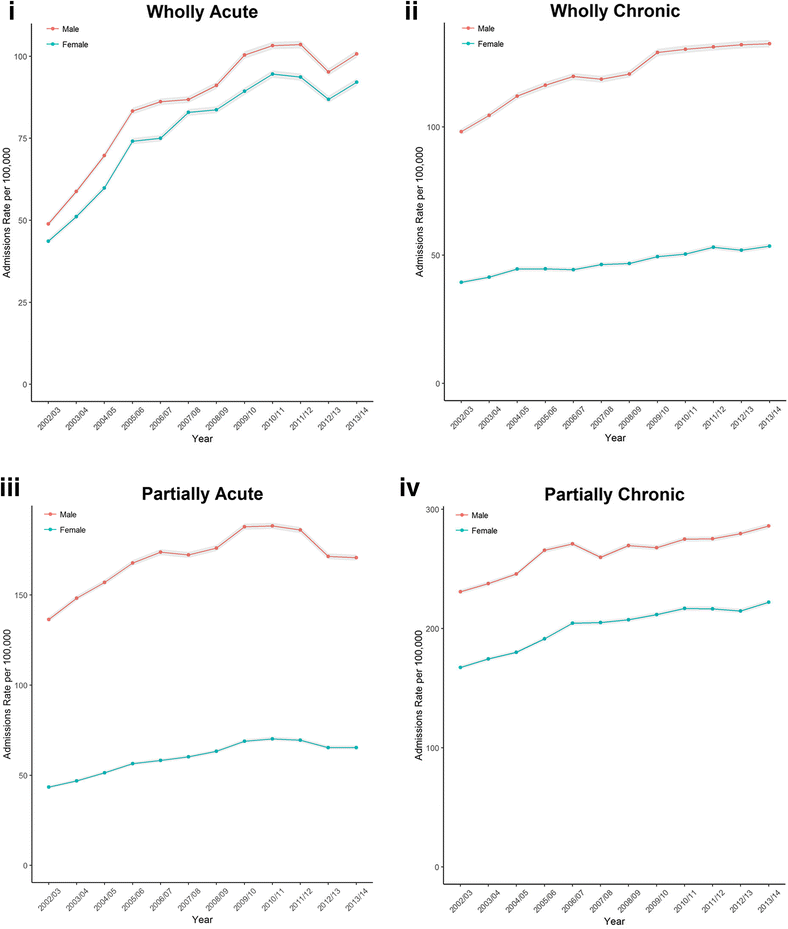
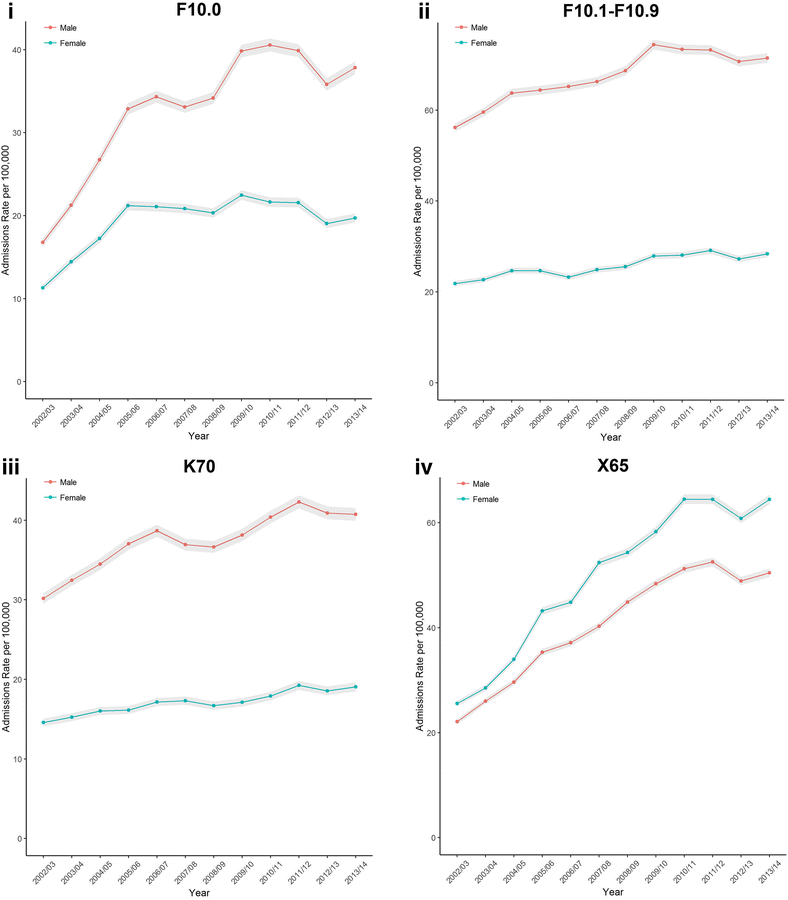
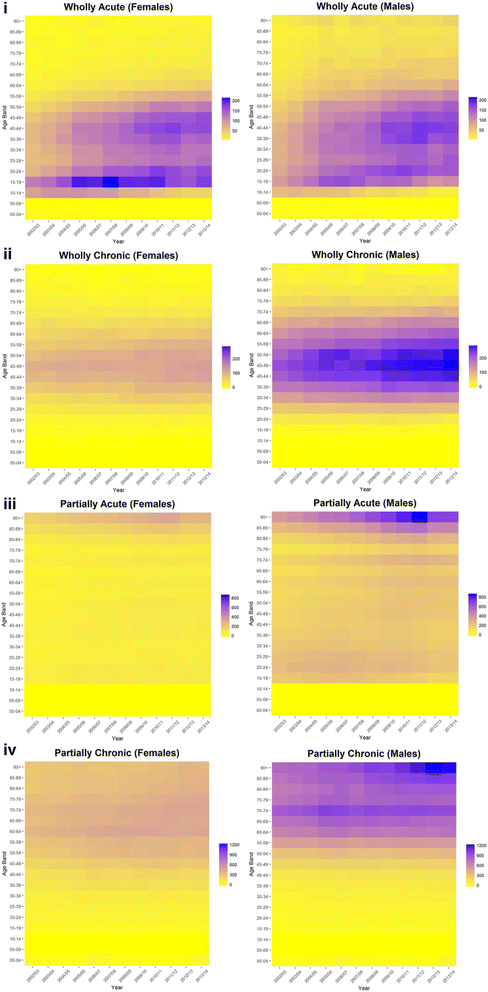
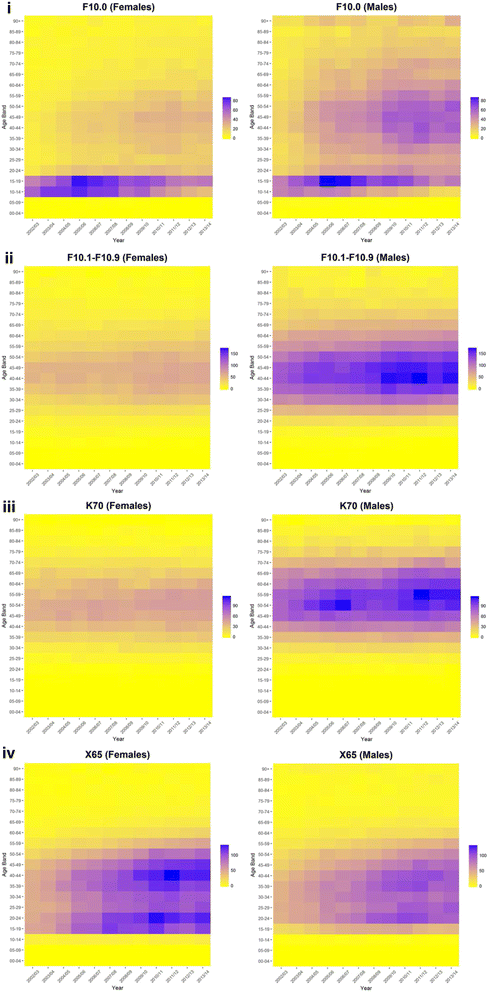
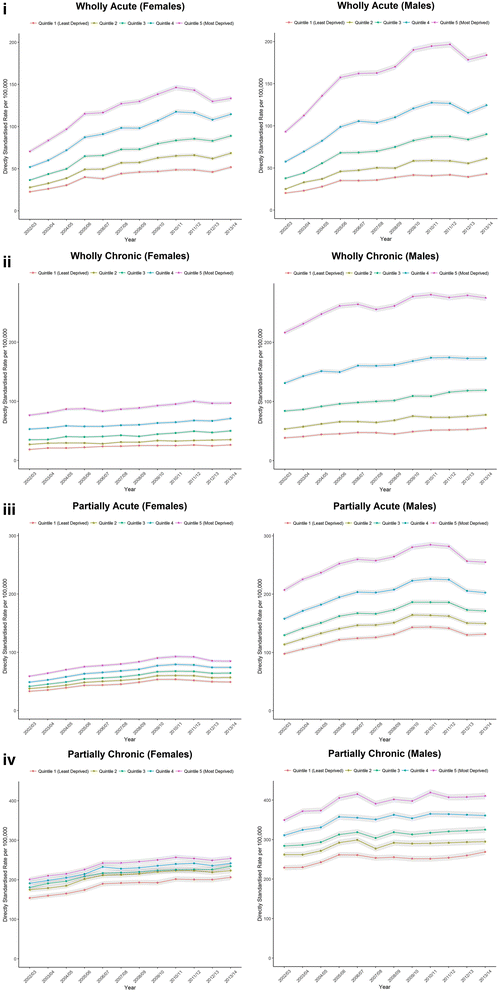
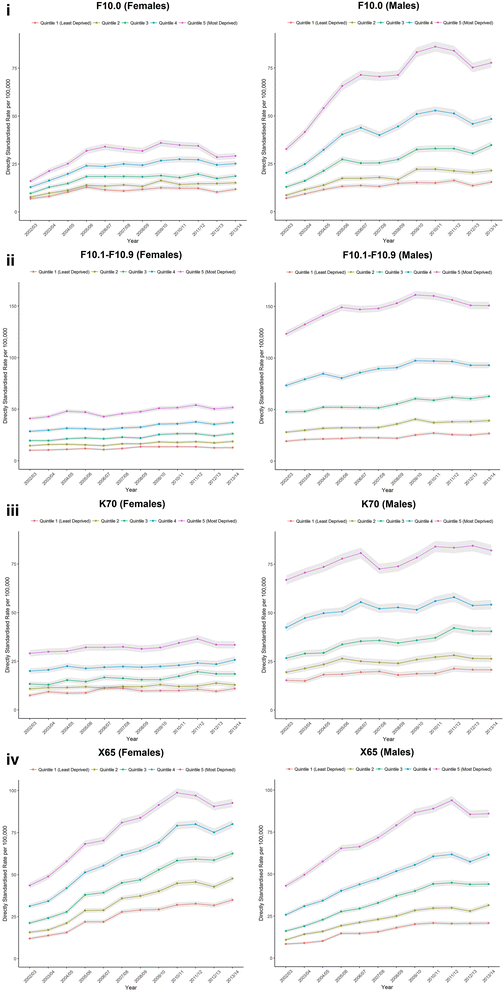
Similar articles
-
Understanding the alcohol harm paradox: an analysis of sex- and condition-specific hospital admissions by socio-economic group for alcohol-associated conditions in England.Addiction. 2017 May;112(5):808-817. doi: 10.1111/add.13726. Epub 2017 Feb 6. Addiction. 2017. PMID: 27981670
-
Socioeconomic deprivation, urban-rural location and alcohol-related mortality in England and Wales.BMC Public Health. 2010 Feb 25;10:99. doi: 10.1186/1471-2458-10-99. BMC Public Health. 2010. PMID: 20184763 Free PMC article.
-
Alcohol outlet density and alcohol related hospital admissions in England: a national small-area level ecological study.Addiction. 2018 Nov;113(11):2051-2059. doi: 10.1111/add.14285. Epub 2018 Aug 19. Addiction. 2018. PMID: 30125420 Free PMC article.
-
[SENTIERI - Epidemiological Study of Residents in National Priority Contaminated Sites. Sixth Report].Epidemiol Prev. 2023 Jan-Apr;47(1-2 Suppl 1):1-286. doi: 10.19191/EP23.1-2-S1.003. Epidemiol Prev. 2023. PMID: 36825373 Italian.
-
Potential effects of minimum unit pricing at local authority level on alcohol-attributed harms in North West and North East England: a modelling study.Southampton (UK): NIHR Journals Library; 2021 Mar. Southampton (UK): NIHR Journals Library; 2021 Mar. PMID: 33764725 Free Books & Documents. Review.
Cited by
-
Rates of emergency department visits attributable to alcohol use in Ontario from 2003 to 2016: a retrospective population-level study.CMAJ. 2019 Jul 22;191(29):E804-E810. doi: 10.1503/cmaj.181575. CMAJ. 2019. PMID: 31332048 Free PMC article.
-
Clinical, Epidemiological and Histopathological Aspects in Patients with Hepatocellular Carcinoma Undergoing Liver Transplantation.Asian Pac J Cancer Prev. 2018 Oct 26;19(10):2795-2802. doi: 10.22034/APJCP.2018.19.10.2795. Asian Pac J Cancer Prev. 2018. PMID: 30360608 Free PMC article.
-
Trends in socioeconomic inequalities in behavioural non-communicable disease risk factors: analysis of repeated cross-sectional health surveys in England between 2003 and 2019.BMC Public Health. 2023 Jul 28;23(1):1442. doi: 10.1186/s12889-023-16275-6. BMC Public Health. 2023. PMID: 37501159 Free PMC article.
-
Nationwide Incidence of Acute Alcohol Intoxication in Adolescents in Belgium: A Validation Study of Belgian Health Insurance Data Through Comparison with Retrospective Hospital Chart Data in Antwerp, Belgium.Children (Basel). 2025 Feb 11;12(2):214. doi: 10.3390/children12020214. Children (Basel). 2025. PMID: 40003316 Free PMC article.
-
Behavioral Risk Factor and Primary Healthcare Utilization in South Africa.Healthcare (Basel). 2022 Oct 31;10(11):2186. doi: 10.3390/healthcare10112186. Healthcare (Basel). 2022. PMID: 36360526 Free PMC article.
References
-
- Newton JN, Briggs ADM, Murray CJL, Dicker D, Foreman KJ, Wang H, et al. Changes in health in England, with analysis by English regions and areas of deprivation, 1990-2013: a systematic analysis for the global burden of disease study 2013. Lancet. 2015;386:2257–2274. doi: 10.1016/S0140-6736(15)00195-6. - DOI - PMC - PubMed
-
- Office for National Statistics. Statistical Bulletin Adult Health in Great Britain, 2012. 2014. Available from: http://www.ons.gov.uk/ons/dcp171778_355938.pdf. Accessed 18 Apr 2017.
MeSH terms
Substances
Grants and funding
LinkOut - more resources
Full Text Sources
Other Literature Sources

